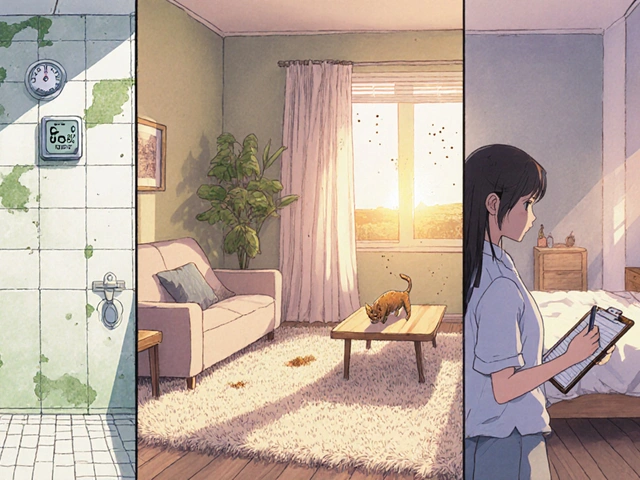Sticky heat turns some people’s skin patchy-light or darker spots that won’t match the rest of your tone. That’s not a bad tan. It’s usually fungus taking advantage of moisture. Here’s the short version, then we’ll dig into the how, the why, and the fixes that actually work.
- Humidity (on your skin and in the air) boosts fungal growth and oil breakdown, which can cause pale or darker patches-often tinea versicolor.
- Keep skin dry, limit occlusion, and use targeted antifungals (e.g., selenium sulfide, ketoconazole). Maintenance prevents relapses.
- Indoor RH under 50-55%, showering right after sweat, and fast-drying fabrics cut risk dramatically.
- Spots often linger after the fungus is gone; pigment can take 4-12 weeks to even out.
- See a GP or dermatologist if the rash is widespread, recurs often, involves folds, or you’re unsure of the diagnosis.
Why humidity fuels fungal skin discoloration
Humidity is more than muggy air-it’s also what sits on your skin under clothing, gear, and hair. When your skin is damp and warm, certain yeasts and fungi get an easy win. The main culprit behind patchy discoloration is Malassezia, a yeast that’s part of normal skin flora. In hot, humid conditions, it overgrows and causes tinea versicolor (also called pityriasis versicolor). The result: light, pink, or brown patches with a fine, branny scale, usually on the chest, back, shoulders, or neck.
Here’s what humidity changes physically:
- Waterlogged skin: The outer layer (stratum corneum) soaks up water, softens, and sheds slower-great conditions for yeast.
- Oil breakdown: Malassezia loves sebum. In humid heat, sweat and oils mix; yeast enzymes turn lipids into free fatty acids that irritate skin.
- Pigment interference: Malassezia byproducts (like azelaic acid) can blunt melanocyte activity, creating pale patches; inflammation can also leave darker marks.
- Occlusion effect: Tight, non-breathable clothes trap sweat and heat, raising local humidity even if the air is dry.
That last bit matters in places like Adelaide. We get dry heat spells, sure, but a 35°C day plus a gym session, backpack straps, or a synthetic footy jersey can create tiny greenhouses on your skin. Bathrooms after a hot shower can sit at 65-75% RH for an hour. Those microclimates are enough to tip you into a flare.
Who’s more at risk?
- Teens and 20-somethings (more oil production).
- Athletes, tradies, bakers, chefs-anyone sweating in gear or heat.
- People with naturally oily skin or a history of dandruff (same yeast).
- Those on steroids, with diabetes, or immunosuppression-more severe or recurrent cases.
How common is this? Dermatology reviews report tinea versicolor affects roughly 2-8% of people in temperate regions and up to 30-50% in tropical climates, peaking during humid seasons. That doesn’t mean Adelaide’s immune-local flares often stack around summer sports, festivals, travel to the tropics, or winter gym sessions in thick layers.
“Tinea versicolor thrives in warm, humid environments and often recurs in summer. Keeping the skin cool and dry and using antifungal treatments can clear the rash.” - American Academy of Dermatology (AAD), guidance reviewed 2025
Public health advice says the same thing. The CDC’s fungal team has long emphasized drying skin folds and removing damp clothing quickly in hot, humid weather. It’s simple, but it’s the backbone of prevention.
How to stop it: step-by-step prevention and treatment
If you clicked this, you probably want a plan you can follow today. Try this flow, and adapt it based on what your skin does over two to four weeks.
- Identify the pattern. Dry, fine scale that scratches off like flour? Patches that look lighter or tan-brown and don’t tan evenly? Trunk and shoulders more than limbs? That points to tinea versicolor. Red, macerated skin with satellite pustules in skin folds (groin, under breasts, armpits)? That leans Candida. Ring-shaped red plaques with a scaly edge on arms/legs? Think tinea corporis (dermatophyte). Unsure? Snap a clear photo in daylight and see your GP.
- Dial down humidity on skin. Aim for “dry and breathable” as your baseline.
- Shower off sweat promptly. If you can’t, wipe down and change tops/bras/undies within 30 minutes.
- Dry thoroughly-especially between toes, groin, under breasts, and along the belt line. A cool setting on a hairdryer helps if skin is sensitive.
- Wear quick-dry fabrics (merino blend, technical polyester) against the skin. Avoid heavy cotton that stays wet.
- At home, crack a window or run a fan during/after showers. Keep indoor RH under 50-55% if possible; a basic hygrometer is cheap and useful.
- Use targeted antifungals the right way.
- Tinea versicolor (trunk/neck): Use selenium sulfide 1% lotion or 2.5% shampoo, or ketoconazole 2% shampoo, as a body wash. Apply to damp skin from jawline to waist, leave on 5-10 minutes, rinse. Do daily for 7-14 days. Ciclopirox 1% cream/shampoo is another option.
- Skin folds (Candida/intertrigo): Clotrimazole 1% or miconazole 2% cream twice daily for 2-4 weeks. Keep folds dry; consider a thin layer of zinc oxide barrier after the antifungal absorbs.
- Ringworm on limbs: Terbinafine 1% or clotrimazole 1% cream twice daily for 2-4 weeks, extend 1-2 cm beyond the edge.
- Add maintenance in humid periods.
- Tinea versicolor loves a comeback. Once clear, use your antifungal shampoo as a body wash once weekly for 2-4 weeks, then monthly during warm months or before/after travel to the tropics.
- If you get scalp dandruff, treat it too-it’s the same yeast. Two to three times per week can reduce trunk relapses.
- Treat the environment.
- Laundry: hot wash where the fabric allows; fully dry clothes and towels. Don’t re-wear damp gym gear.
- Footwear: rotate shoes; use moisture-wicking socks; remove insoles to dry overnight.
- Gear: wipe down backpack straps and sports pads; line-dry in sun when you can-UV helps.
- Mind the skin barrier.
- Use gentle, pH-balanced cleansers. Skip heavy oils on the chest/back during humid weeks. Non-comedogenic sunscreen only.
- Don’t scrub hard. Over-exfoliating inflames skin and can deepen hyperpigmentation after the rash clears.
- Know when to see a doctor.
- No improvement after 2 weeks of correct topical treatment.
- Widespread areas, frequent recurrences (3+ times/year), or involvement of hair-bearing areas.
- Signs of bacterial infection (ooze, honey-colored crust, fever) or severe pain.
- Consider oral therapy (itraconazole/fluconazole) only under medical guidance-these interact with common meds (e.g., statins) and may need liver checks.
Small Adelaide note: summers can be dry, but post-storm humidity spikes and festival weeks (lots of sweat and sunscreen) are prime relapse windows. I keep a ketoconazole shampoo in the shower all summer and use it on my neck and shoulders after sport-quick in, quick out.

Examples, checklists, and the data behind the advice
Want a simple framework? Try this rule of thumb:
- The 5-5-30 rule: Keep indoor RH under 55%. Shower within 5 minutes of finishing sweaty activity. Change out of damp clothes within 30 minutes.
Now the practical bits you can use today.
Checklists
- Daily routine: brief lukewarm shower, antifungal wash if treating, pat dry, antifungal cream (if needed), light lotion only on dry areas, non-comedogenic sunscreen.
- Gym bag: spare top/undies/socks, microfiber towel, travel-size antifungal wash, body wipes, ziplock for damp clothes.
- Laundry: wash gym gear after each wear, full dry cycle, sun-dry when possible.
- Skin folds: after drying, light dusting with absorbent powder (cornstarch-free talc alternatives) or thin zinc barrier-avoid caking.
- Travel to tropics: start weekly prophylaxis 1 week before; pack quick-dry clothes; book a room with a fan or AC if you can.
Decision cues
- Pale patches get more obvious after sun? Likely tinea versicolor; start antifungal wash cycle.
- Red, sore, wet-looking rash in a fold with little satellite spots? Candida-use clotrimazole/miconazole and keep it dry.
- Annular (“ring”) patch with a raised scaly edge on an arm or thigh? Terbinafine/clotrimazole cream for 2-4 weeks; avoid steroid-only creams.
Common pitfalls
- Stopping too early: fungus dies in days; pigment takes weeks. Continue maintenance to prevent bounce-back.
- Using steroid-only creams: they can hide redness and make fungus spread (tinea incognito). Avoid unless combined with antifungal under medical advice.
- Heavy oils on trunk in summer: lovely for elbows, not for oily chest/backs during humid weeks.
- Forgetting the scalp: dandruff control reduces trunk recurrences.
Local climate angle (Adelaide): peak risk isn’t only January heat. Winter gyms (heated, humid), autumn festivals, and tropical holidays are common flare times. If you cycle through those, set calendar reminders for your weekly prophylaxis wash.
| Factor | Threshold / Number | What it means for your skin |
|---|---|---|
| Relative Humidity (RH) indoors | Under 50-55% | Yeasts grow slower; less maceration and sweat build-up on skin. |
| Shower timing after sweat | Within 5-30 minutes | Shortens the “wet window” that fuels yeast overgrowth. |
| Antifungal shampoo contact time (body use) | 5-10 minutes | Enough exposure to hit the yeast; rinse after. |
| Initial treatment duration (tinea versicolor) | 7-14 days daily | Clears active yeast in most cases. |
| Maintenance during warm months | 1× weekly, then monthly | Cuts relapse risk substantially. |
| Pigment recovery time | 4-12 weeks | Color normalizes after inflammation settles; fungus may be gone before that. |
| Prevalence in temperate climates | Approx. 2-8% | Seasonal spikes-often summer or during periods of heavy sweating. |
| Prevalence in tropical climates | Approx. 30-50% | Persistent humidity drives higher rates and frequent recurrences. |
Evidence note: These ranges reflect dermatology texts and reviews, plus AAD and CDC guidance on moisture, antifungal use, and recurrence patterns.
FAQ and next steps
Why do spots stick around after I’ve treated them? Your immune system clears the yeast quickly, but melanocytes are slower to reset. Pale patches need fresh melanin; darker marks need inflammation to fade. Expect 4-12 weeks. Sunscreen helps tone look more even while you wait.
Is this contagious? Malassezia is normal skin flora, so classic person-to-person spread is uncommon. But shared damp gear and close skin contact in humid conditions can tip someone who’s already susceptible. Wipe down equipment and don’t share towels.
Can tanning hide the patches? It does the opposite-pale areas stand out more after a tan. Stick with sunscreen and let pigment catch up.
Natural options? Tea tree oil has antifungal properties, but it can irritate and cause dermatitis-especially on the neck and chest. If you try it, dilute heavily and patch test. For most people, evidence-backed, low-irritant options like selenium sulfide or ketoconazole are safer and more reliable.
What about benzoyl peroxide? It’s antibacterial and mildly antifungal. A 5% wash can help body acne and reduce yeast, but it bleaches fabric and can irritate. Use with care and moisturize dry areas.
Kids and pregnancy? Many topical antifungals (like clotrimazole) are considered safe in pregnancy; selenium sulfide is commonly used but ask your doctor. For children, avoid prolonged contact times and keep products away from eyes and mouth. When in doubt, GP first.
When do I need pills? Very widespread or recurrent tinea versicolor sometimes needs a short oral course (e.g., itraconazole/fluconazole). These can interact with medicines (statins, some antihistamines, certain psych meds) and aren’t for everyone. That’s a doctor-only decision.
Why do I get this every summer? You likely have a combination of oily skin, high sweat activity, and clothing/gear that traps humidity. Maintenance washes and fabric changes usually break the cycle.
Could it be something else? Yes-vitiligo (no scale, chalk-white borders), pityriasis alba (kids, mild dry pale patches), post-inflammatory hypopigmentation after eczema, or even early psoriasis. If the scale test (scrape gently; fine powdery scale appears) is negative and patches don’t budge with antifungals, see a GP.
Best fabrics? For base layers: merino blends or technical synthetics that wick and dry fast. For outer layers: loose and breathable. Skip plastic-backed caps and tight compression tops during flares unless you absolutely need them.
Face and neck care? Use the same antifungal shampoo as a short-contact wash (1-3 minutes) every second day during a flare. Moisturize lightly after if needed and use a non-comedogenic sunscreen.
Does diet matter? There’s no solid evidence that sugar directly causes tinea versicolor, but high heat, alcohol, and spicy food can increase flushing and sweat. If a trigger makes you sweat more, it can indirectly worsen flares.
Can deodorant or sunscreen cause discoloration? Not directly. Occlusive products can trap sweat and oil though. Choose non-comedogenic, fast-dry formulas and reapply on clean skin when possible.
What if my bathroom is a steam cave? Vent fans, open windows, shorter showers, and squeegee surfaces to cut lingering moisture. A small dehumidifier can be a game-changer in older homes without good ventilation.
Next steps, tailored:
- Athletes/tradies: Pack spare base layers. Schedule a 2-minute rinse after training. Use antifungal shampoo as a body wash three times weekly for 2 weeks, then weekly until the season cools.
- Office workers who gym at lunch: Keep a minimalist kit: travel wash, microfiber towel, spare shirt. Even a sink rinse and blow-dry beats staying damp till 5 pm.
- New parents: Skin-to-skin and humidity are great for babies, not for yeast. Keep your chest dry between feeds; change damp tops; treat your own tinea versicolor so baby skin isn’t constantly in a humid patch.
- Travellers to the tropics: Start prophylaxis 7 days before, continue weekly while away, and for 2 weeks after coming home. Choose loose linen/merino, and book accommodation with a fan or AC if you can swing it.
- Recurrent or stubborn cases: Ask your GP about confirming the diagnosis (KOH test/wood’s lamp), consider oral therapy if appropriate, and discuss scalp treatments if you have dandruff. Review meds for interactions before starting pills.
Bottom line: humidity-on your skin and in the air-sets the stage for fungal skin discoloration. Control moisture, use the right antifungal with the right contact time, and keep a simple maintenance routine in humid weeks. That’s how you cut through the relapse cycle and keep your skin tone steady.






OMG YES this is so real 😭 I had tinea versicolor for 3 summers straight until I started using ketoconazole shampoo as a body wash once a week. My chest used to look like I got into a fight with a highlighter. Now? Just sunscreen and chill. 🙌
bro i just use deodorant on my chest now and call it a day. why are we overcomplicating this? i don’t even shower after gym sometimes. my skin’s fine. 🤷♂️
While I appreciate the practical advice, it’s worth noting that the assumption that all discoloration is fungal is dangerously reductive. Many patients self-diagnose tinea versicolor when it’s actually vitiligo, pityriasis alba, or even early cutaneous T-cell lymphoma. The absence of scale, lack of response to antifungals, or symmetrical depigmentation should trigger referral-not another bottle of selenium sulfide. Proper dermatologic evaluation is not a luxury; it’s standard of care.
Additionally, recommending daily antifungal washes without addressing barrier disruption risks iatrogenic dermatitis. The stratum corneum is not a sponge to be scrubbed clean. Moisture management is critical, yes-but so is lipid restoration. Many of these patients need ceramide-containing cleansers, not more antifungals.
And while ‘keep RH under 55%’ sounds reasonable, most homes in the U.S. average 40-60% year-round. That’s not a fix-it’s a baseline. The real issue is prolonged occlusion from synthetic fabrics and inadequate drying. Recommend a $12 hygrometer? Fine. But don’t pretend humidity control alone solves this. It’s one variable in a multivariate equation.
Also, ‘don’t use steroid-only creams’ is correct, but the warning should be stronger. Tinea incognito can mask progression for months. I’ve seen patients with full-body fungal overgrowth because they were on hydrocortisone for ‘eczema’ for two years. That’s malpractice waiting to happen.
And please stop telling people to use tea tree oil. It’s not ‘natural’-it’s a potent allergen. Patch testing isn’t optional. I’ve treated three cases of allergic contact dermatitis from ‘natural remedies’ this month alone.
Bottom line: This is not a DIY condition. Empowerment is good. Overconfidence is dangerous.
Man, I just want to say thank you for writing this with such clarity. I’m from Vancouver, and last summer I thought I was just getting ‘sun spots’-turns out I had tinea versicolor creeping up my neck from all that hiking in damp gear. I was using cotton tees and thinking ‘it’s just sweat’-big mistake.
After reading this, I switched to merino base layers, started carrying a microfiber towel in my pack, and started using ketoconazole shampoo once a week after workouts. It’s been 8 months and zero recurrence. I even bought a little portable dehumidifier for my bathroom-best $40 I’ve ever spent.
Also, the bit about dandruff being connected? Game-changer. I had flaky scalp for years and never linked it. Now I wash my hair with the same shampoo I use on my chest. No more ‘dandruff’ and no more chest patches. My dermatologist was shocked I figured it out on my own.
And to the guy who said ‘just use deodorant’-no. Please don’t. I’ve seen what happens when you ignore fungal overgrowth. It doesn’t just stay on the chest. It migrates. It gets stubborn. It turns into a full-blown flare-up that takes months to clear. You’re not saving time-you’re just delaying the inevitable.
Also, if you’re in a humid climate, don’t wait for symptoms. Prophylaxis is your friend. Set a calendar reminder. Use the shampoo. It’s not a treatment-it’s maintenance, like brushing your teeth. You don’t wait until you have a cavity to start flossing.
And to the person who said ‘natural remedies’-please don’t. I’ve seen tea tree oil burn someone’s neck so bad they needed a steroid shot. Antifungals are safe, tested, and cheap. Don’t gamble with your skin.
Thank you again for this. It’s rare to see a post that’s this detailed, accurate, and actually useful. I’m sharing this with my whole hiking group.
YASSSS this is literally my life story 😭 I’m a yoga teacher and I sweat ALL THE TIME. Used to get these weird white patches on my back and thought I was turning into a ghost. Tried everything-coconut oil, apple cider vinegar rinse (big mistake), even ‘sun therapy’ lol. Then I tried the ketoconazole shampoo like 2x a week and BOOM. Gone in 10 days.
Now I keep a mini bottle in my gym bag and use it after class. Also switched to bamboo leggings-so much better than cotton. And I crack the window after showers like a boss. 🌿✨
To the guy saying ‘just use deodorant’-nope. That’s how you end up with a fungal rave on your back. Don’t be that person. 💅
Of course it’s fungus. Because everything in 2025 is a fungus. You sneeze? Fungus. Your WiFi drops? Fungus. Your ex ghosted you? Probably a fungal biofilm in their emotional cortex.
Let me guess-you’re also telling people to ‘maintain’ with antifungal shampoo like it’s a religious ritual. Next you’ll be selling $80 ‘microclimate-certified’ socks. The real fungus here is the medical-industrial complex that profits off people fearing their own sweat.
Also, ‘use a hygrometer’? Wow. Next you’ll recommend we install a NASA-grade air scrubber in our bathrooms. Chill. Your skin is not a sterile lab. It’s evolved to handle moisture. You’re not treating a disease-you’re fighting evolution with a bottle of shampoo.
And don’t even get me started on ‘don’t use steroids.’ You know what cures inflammation? Time. And maybe not wearing polyester for 12 hours straight. Not another antifungal wash.
Just breathe. It’s not a plague. It’s just your skin being a skin. Let it be.
I’m from Nigeria and moved to Texas last year. I had no idea this was a thing until I got these pale patches after my first humid summer here. Back home, everyone just says ‘it’s the heat’ and moves on. But here, people panic and go straight to the dermatologist.
What helped me most was learning that it’s not about being ‘clean’-it’s about being dry. I started changing clothes immediately after sweating, even if I was just walking to the car. Used to think that was overkill. Now I carry a small towel in my backpack like a pro.
Also, the part about scalp dandruff? Eye-opener. I used to treat my scalp separately, but once I started using ketoconazole shampoo on my hair and body together, the chest patches vanished. No more ‘two problems’-just one yeast, two locations.
And to the person who said ‘just use deodorant’-I get the vibe, but trust me, if you’ve ever had this spread to your shoulders and neck, you’ll know it’s not worth the gamble. It’s not embarrassing-it’s just annoying. And treatable.
Thanks for the detailed guide. This is the kind of post that actually saves people from years of confusion.